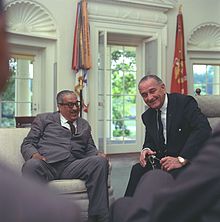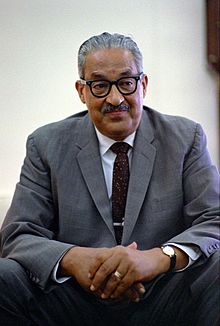
Thoroughgood "Thurgood" Marshall was an American civil rights lawyer and jurist who served as an associate justice of the Supreme Court of the United States from 1967 until 1991. He was the Supreme Court's first African-American justice. Prior to his judicial service, he was an attorney who fought for civil rights, leading the NAACP Legal Defense and Educational Fund. Marshall was a prominent figure in the movement to end racial segregation in American public schools. He won 29 of the 32 civil rights cases he argued before the Supreme Court, culminating in the Court's landmark 1954 decision in Brown v. Board of Education, which rejected the separate but equal doctrine and held segregation in public education to be unconstitutional. President Lyndon B. Johnson appointed Marshall to the Supreme Court in 1967. A staunch liberal, he frequently dissented as the Court became increasingly conservative.
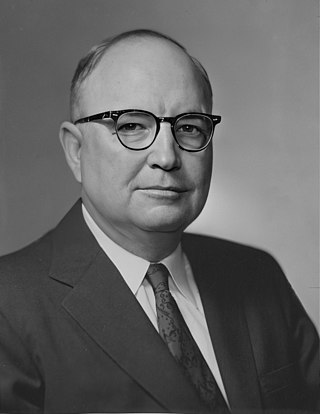
James Oliver Eastland was an American attorney, plantation owner, and politician from Mississippi. A Democrat, he served in the United States Senate in 1941 and again from 1943 until his resignation on December 27, 1978. Eastland was a racist who led the Southern resistance against racial integration during the civil rights movement, often speaking of African Americans as "an inferior race." Eastland has been called the "Voice of the White South" and the "Godfather of Mississippi Politics."

Abraham Fortas was an American lawyer and jurist who served as an associate justice of the Supreme Court of the United States from 1965 to 1969. Born and raised in Memphis, Tennessee, Fortas graduated from Rhodes College and Yale Law School. He later became a law professor at Yale Law School and then an advisor for the U.S. Securities and Exchange Commission. Fortas worked at the Department of the Interior under President Franklin D. Roosevelt, and was appointed by President Harry S. Truman to delegations that helped set up the United Nations in 1945.

The Supreme Court of the United States is the highest-ranking judicial body in the United States. Established by Article III of the Constitution, the detailed structure of the court was laid down by the 1st United States Congress in 1789. Congress specified the Court's original and appellate jurisdiction, created 13 judicial districts, and fixed the initial size of the Supreme Court. The number of justices on the Supreme Court changed six times before settling at the present total of nine in 1869. As of June 2022, a total of 116 justices have served on the Supreme Court since 1789. Justices have life tenure, and so they serve until they die in office, resign or retire, or are impeached and removed from office.

Speculation abounded over potential nominations to the Supreme Court of the United States by President George W. Bush since before his presidency.

On July 1, 1991, President George H. W. Bush nominated Clarence Thomas for the Supreme Court of the United States to replace Thurgood Marshall, who had announced his retirement. At the time of his nomination, Thomas was a judge on the United States Court of Appeals for the District of Columbia Circuit; President Bush had appointed him to that position in March 1990.
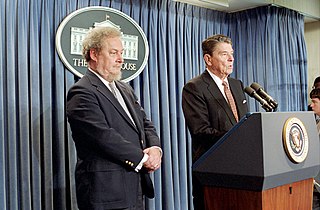
On July 1, 1987, President Ronald Reagan nominated Judge Robert Bork for Associate Justice of the Supreme Court of the United States, to succeed Lewis F. Powell Jr., who had earlier announced his retirement. At the time of his nomination, Bork was a judge on the United States Court of Appeals for the District of Columbia Circuit, a position to which he had been appointed by President Reagan in 1982.
During President Lyndon B. Johnson's presidency, federal judicial appointments played a central role. Johnson appointed Abe Fortas and Thurgood Marshall to the Supreme Court of the United States in just over five years as president.
The nominations made by Lyndon B. Johnson to the Supreme Court of the United States are unusual in that Johnson appeared to have had specific individuals in mind for his appointments and actively sought to engineer vacancies on the Court to place those individuals on the court.

The nomination and confirmation of justices to the Supreme Court of the United States involves several steps, the framework for which is set forth in the United States Constitution. Specifically, Article II, Section 2, Clause 2, provides that the president of the United States nominates a justice and that the United States Senate provides advice and consent before the person is formally appointed to the Court. It also empowers a president to temporarily, under certain circumstances, fill a Supreme Court vacancy by means of a recess appointment. The Constitution does not set any qualifications for service as a justice, thus the president may nominate any individual to serve on the Court.
U.S. President Barack Obama nominated over 400 individuals for federal judgeships during his presidency. Of these nominations, Congress confirmed 329 judgeships, 173 during the 111th & 112th Congresses and 156 during the 113th and 114th Congresses.

On May 10, 2010, President Barack Obama announced his selection of Elena Kagan for Associate Justice of the Supreme Court of the United States, to replace retiring Justice John Paul Stevens. Kagan's nomination was confirmed by a 63–37 vote of the United States Senate on August 5, 2010. When nominated, Kagan was Solicitor General of the United States, a position to which Obama had appointed her in March 2009. Kagan was the first Supreme Court nominee since Sandra Day O'Connor in 1981 to not be a sitting circuit court judge and the most recent such nominee as of 2023. She was the first Supreme Court nominee since William Rehnquist and Lewis F. Powell Jr. in 1971 to not be a sitting judge on any court.
Donald Trump, President of the United States from 2017 to 2021, entered office with a significant number of judicial vacancies, including a Supreme Court vacancy due to the death of Antonin Scalia in February 2016. During the first eight months of his presidency, he nominated approximately 50 judges, a significantly higher number than any other recent president had made by that point in his presidency. By June 24, 2020, 200 of his Article III nominees had been confirmed by the United States Senate. According to multiple media outlets, Trump significantly impacted the composition of the Supreme Court and lower courts during his tenure.
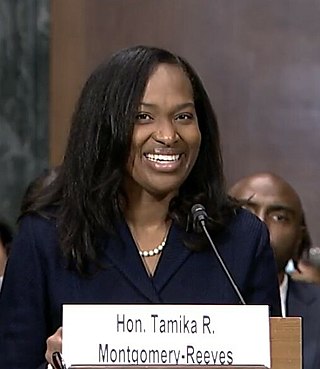
Tamika Renee Montgomery-Reeves is an American lawyer who serves as a United States circuit judge of the United States Court of Appeals for the Third Circuit. She previously served as an Associate Justice of the Delaware Supreme Court.

On September 26, 2020, President Donald Trump announced the nomination of Amy Coney Barrett to the position of Associate Justice of the Supreme Court of the United States to fill in the vacancy left by the death of Ruth Bader Ginsburg. At the time of her nomination, Barrett was a Judge of the United States Court of Appeals for the Seventh Circuit in Chicago, Illinois. The Senate received word from the president on September 29.
President Joe Biden began his presidency with fewer vacancies to fill than his predecessor. He pledged to nominate people with diverse backgrounds and professional experience; further he pledged to nominate the first black woman to the Supreme Court of the United States.

On February 25, 2022, President Joe Biden announced that he would nominate Ketanji Brown Jackson to the position of associate justice of the Supreme Court of the United States to fill the vacancy by Stephen Breyer, who announced his retirement on January 27, 2022, at the age of 83. Jackson, a former law clerk of Breyer, was a judge on the United States Court of Appeals for the District of Columbia Circuit, having been appointed by Biden in 2021. Jackson is the first Black woman in U.S. history to be nominated to serve on the U.S. Supreme Court.
Harlan F. Stone was nominated and confirmed twice to the Supreme Court of the United States. First in 1925, when President Calvin Coolidge nominated him to serve as an associate justice and again in 1941, when President Franklin D. Roosevelt nominated Justice Stone to be elevated to Chief Justice. Both times, the United States Senate confirmed the nominations.

Louis Brandeis was nominated to serve as an associate justice of the Supreme Court of the United States by U.S. President Woodrow Wilson on January 28, 1916, after the death in office of Joseph Rucker Lamar created a vacancy on the Supreme Court. Per the Constitution of the United States, Brandeis' nomination was subject to the advice and consent of the United States Senate, which holds the determinant power to confirm or reject nominations to the U.S. Supreme Court.
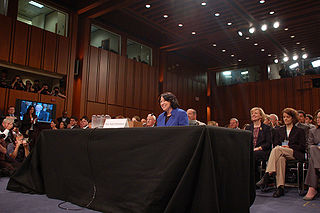
Since the creation of the Senate Committee on the Judiciary in 1816, many, but not all, nominations for the Supreme Court of the United States have been first referred to a committee for review prior to facing a confirmation vote before the full United States Senate. Some nominations have been withdrawn, lapsed, or been postponed without being referred to the Judiciary Committee, while some others up until 1941 had proceeded to full Senate confirmation votes without first being reviewed by the Judiciary Committee. However, ever since 1941, all nominations have been referred to the Judiciary Committee.
